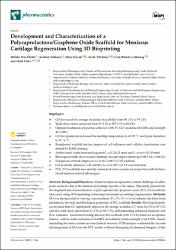Development and Characterization of a Polycaprolactone/Graphene Oxide Scaffold for Meniscus Cartilage Regeneration Using 3D Bioprinting

Göster/
Erişim
info:eu-repo/semantics/openAccessTarih
2025Yazar
Özder, Melike NurYelkenci, Aslıhan
Kuçak, Mine
Altınbay, Aylin
Üstündağ, Cem Bülent
Çiftçi, Fatih
Üst veri
Tüm öğe kaydını gösterKünye
ÖZDER, Melike Nur, Aslıhan YELKENCİ, Mine KUÇAK, Aylin ALTINBAY, Cem Bülent ÜSTÜNDAĞ & Fatih ÇİFTÇİ. "Development and Characterization of a Polycaprolactone/Graphene Oxide Scaffold for Meniscus Cartilage Regeneration Using 3D Bioprinting". Pharmaceutics, 17.346 (2025): 1-21.Özet
Meniscus injuries represent a critical challenge in orthopedic
medicine due to the limited self-healing capacity of the tissue. This study presents the
development and characterization of polycaprolactone/graphene oxide (PCL/GO) scaffolds
fabricated using 3D bioprinting technology for meniscus cartilage regeneration.Methods:
GO was incorporated at varying concentrations (1%, 3%, 5% w/w) to enhance the bioactivity,
mechanical, thermal, and rheological properties of PCL scaffolds. Results: Rheological analyses
revealed that GO significantly improved the storage modulus (G’) from 36.1 Pa to 97.1 Pa
and the yield shear stress from 97.2 Pa to 507.1 Pa, demonstrating enhanced elasticity and
flow resistance. Mechanical testing showed that scaffolds with 1% GO achieved an optimal
balance, with an elasticmodulus of 614MPa and ultimate tensile strength of 46.3MPa, closely
mimicking the native meniscus’s mechanical behavior. FTIR analysis confirmed the successful
integration of GO into the PCL matrix without disrupting its chemical integrity, while DSC analysis indicated improved thermal stability, with increases in melting temperatures.
SEManalysis demonstrated a roughened surface morphology conducive to cellular adhesion
and proliferation. Fluorescence microscopy using DAPI staining revealed enhanced cell
attachment and regular nuclear distribution on PCL/GO scaffolds, particularly at lower
GO concentrations. Antibacterial assays exhibited larger inhibition zones against E. coli and
S. aureus, while cytotoxicity tests confirmed the biocompatibility of the PCL/GO scaffolds
with fibroblast cells. Conclusions: This study highlights the potential of PCL/GO 3D-printed
scaffolds as biofunctional platforms for meniscus tissue engineering, combining favorable
mechanical, rheological, biological, and antibacterial properties.


















